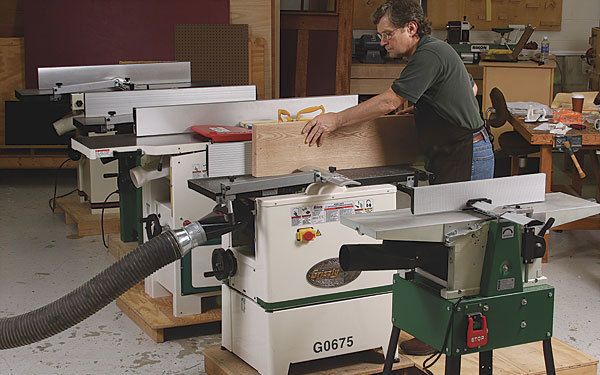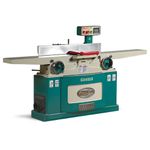Tool test: Jointer/planer combination machines
New breed of affordable machines lets you do more in less space
Synopsis: The pool of jointer-planer combo machines has grown in the five years since we tested this machine, which blends a wide jointer with an industrial-strength planer. With North American manufacturers now building less-expensive models, Roland Johnson put five machines with a street price under $2,400 to the test. The big question was: What do you lose, if anything, by going with one of these less-expensive models? To test the machines, Johnson milled an array of exotic, domestic, and figured wood—all of which are commonly used to make furniture. He also timed each machine’s changeover, which is the time it takes to convert the machine between jointing and planing modes. He also tested the machines’ dust-collection mechanisms, and evaluated their general performance.
Models tested include: Grizzly G0634XP, Jet JJP-12, Rikon 25-200, Grizzly G0675, Rikon 25-010
From Fine Woodworking #225
Jointer-planer combos, long popular in Europe, have made serious inroads in North America, for two good reasons. For one, they save space, putting the two essential milling machines into one small footprint. Perhaps more importantly, they get you a wide jointer—one of the gateways to truly efficient woodworking—plus an industrial-strength planer, for close to the price of the big jointer alone. That said, not everyone is ready to plunk down $3,000-plus to upgrade the jointer and planer they already have.
When I last tested combination machines in 2007 (FWW #190), three of the four were European-made machines with 12-in. cutterheads and stout price tags. Since then, however, increased interest and competition have prompted several manufacturers to begin building and marketing less-expensive models.
For this test, we were able to cap the street price at $2,400, with a few available for far less, putting them in a range that we believe most hobbyist woodworkers or small-shop owners would be willing to pay. The big question is: What do you lose, if anything, by going with one of these less-expensive models?
I tested five machines—two each from Grizzly and Rikon and one from Jet—by milling an array of exotic, domestic, and figured wood—all of which are commonly used to make furniture. Just as importantly, I timed each machine’s changeover, which is the time it takes to convert the machine between jointing and planing modes. Changeover is a key measurement for jointer/planer combination machines, and a common concern for woodworkers who are used to working with separate machines. I also tested the machines’ dust-collection mechanisms, and evaluated their general performance.
When it comes to planing quality, the differences among machines are negligible. All five delivered excellent cuts with minimal snipe when removing up to 1⁄16 in. of material in a single pass over wide boards. Differences in dust collection and general performance also were minimal. For those core functions, the machines all performed similarly, and compared well with their pricier cousins from the last review.
There are moderate differences in the machines when it comes to changeover. The good news is that changeovers on the best machines in this test were better than the previous crop I tested. The fastest in this group took just over 20 seconds to switch between jointing and planing, while the slowest took more than a minute. I found the biggest differences among the machines in the nitty-gritty details—the ease with which fences and settings can be adjusted or changed, or the difficulty involved in changeover.
For the full article, download the PDF below.
Fine Woodworking Recommended Products

Ridgid EB4424 Oscillating Spindle/Belt Sander

Grizzly G0495X Industrial Helical Cutterhead 8-in. Jointer

DeWalt 735X Planer























Log in or create an account to post a comment.
Sign up Log in